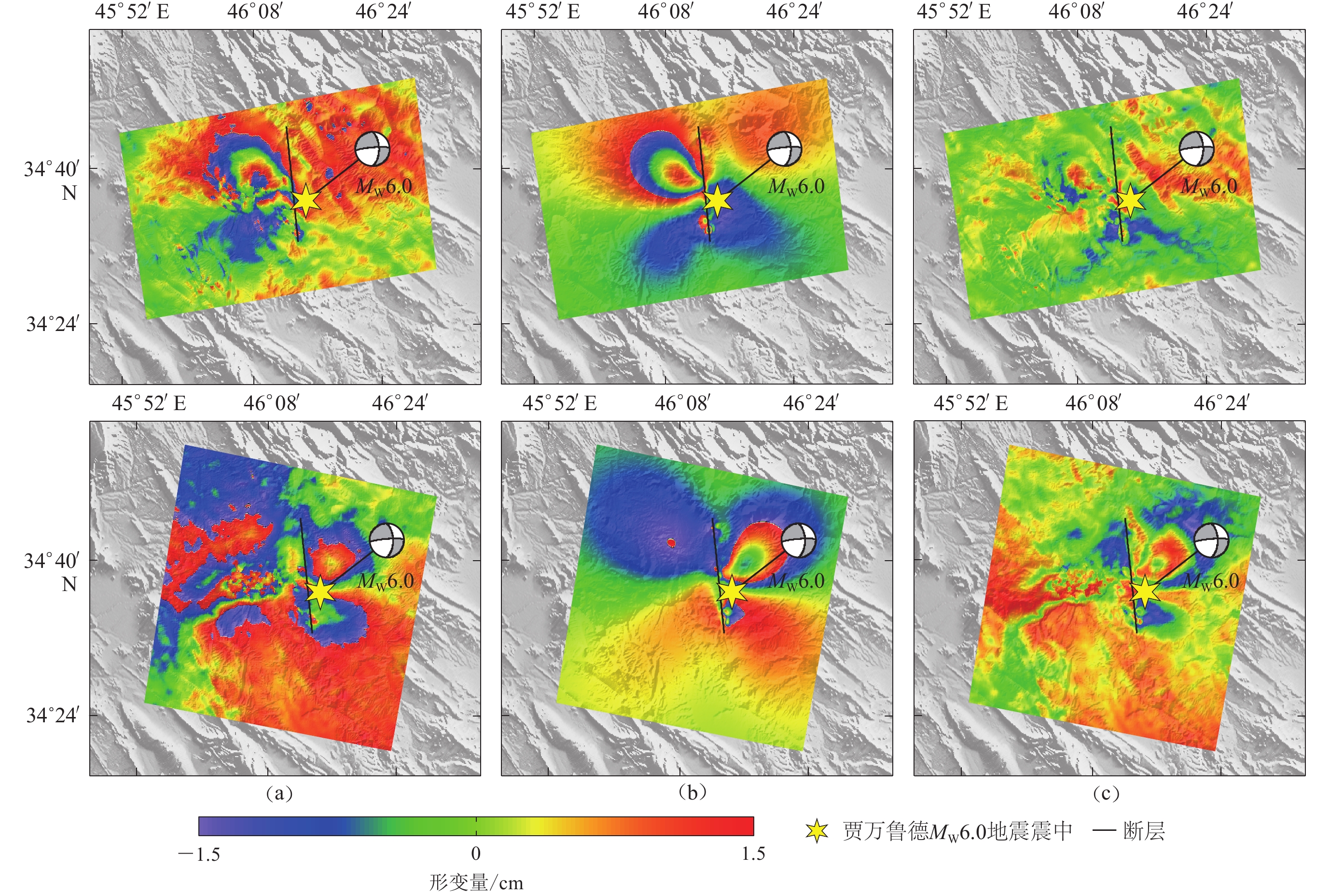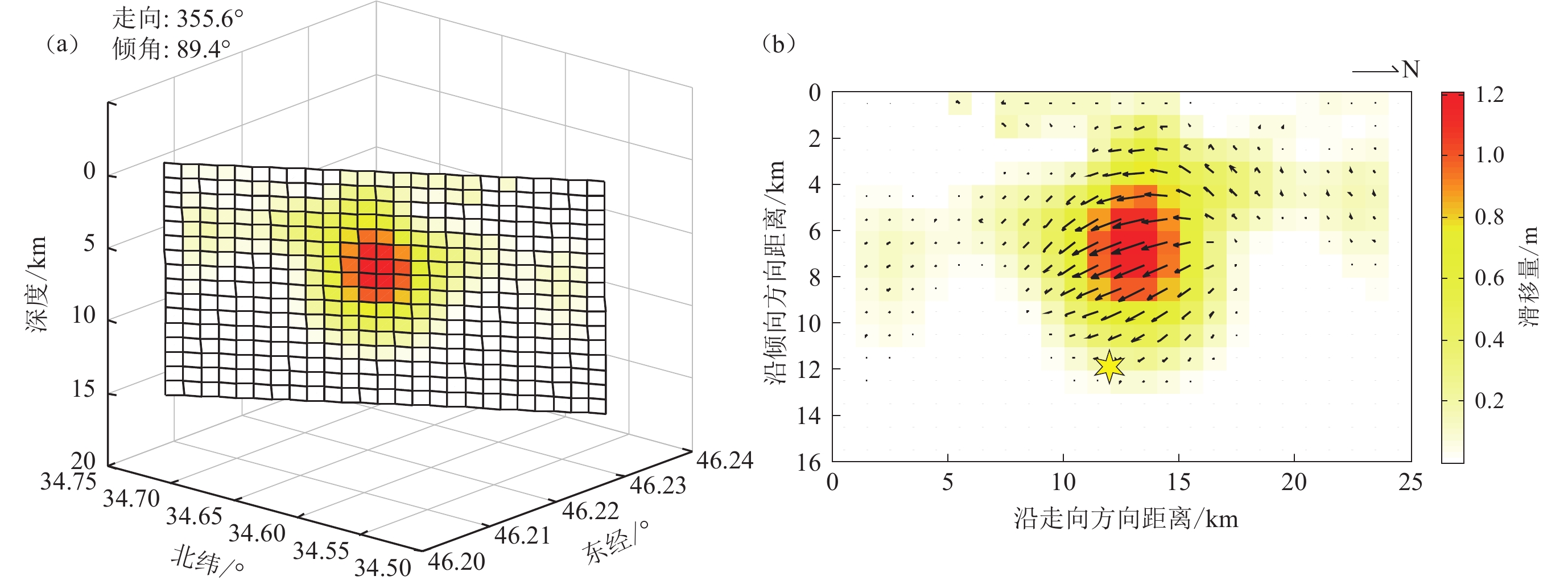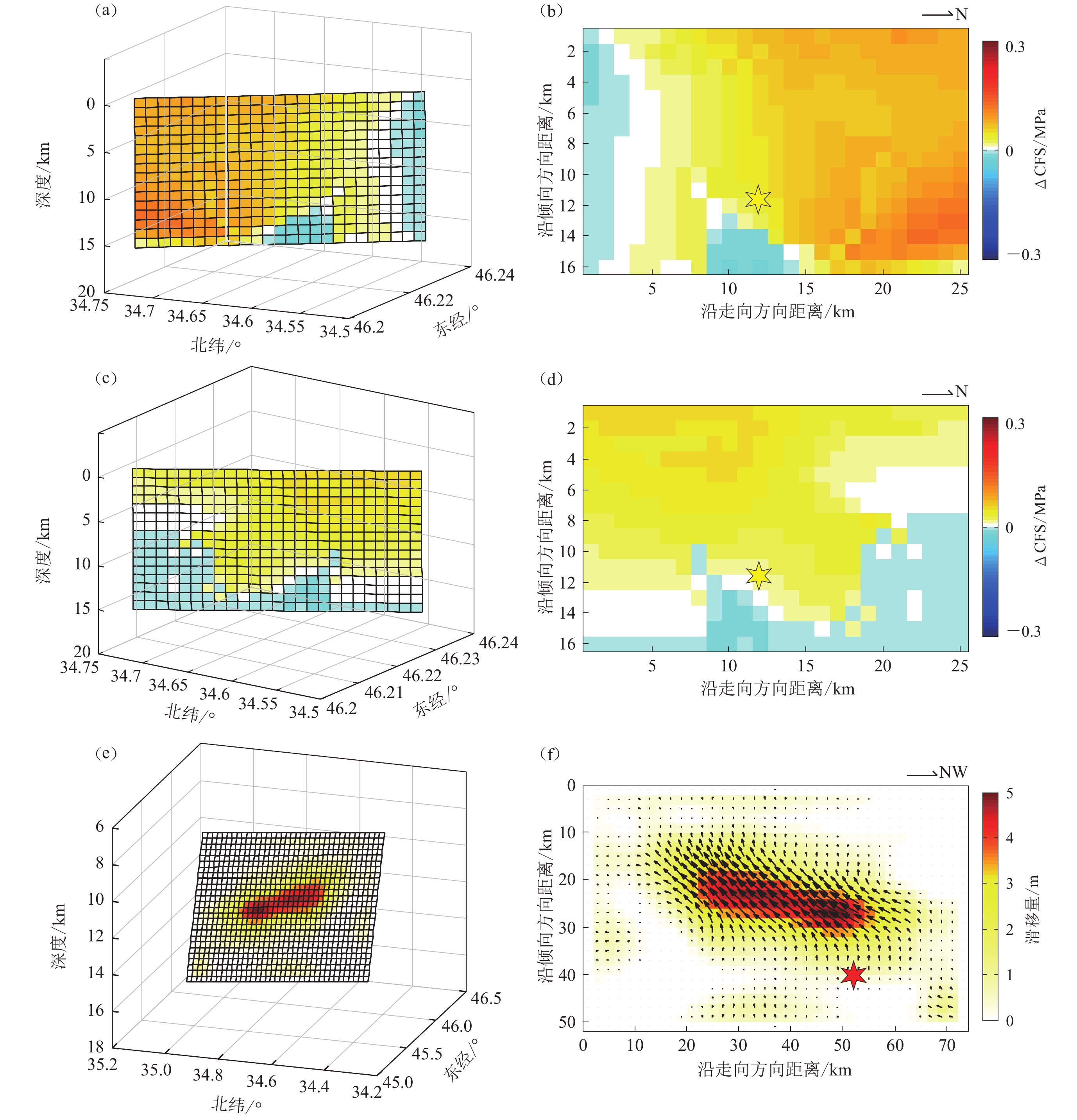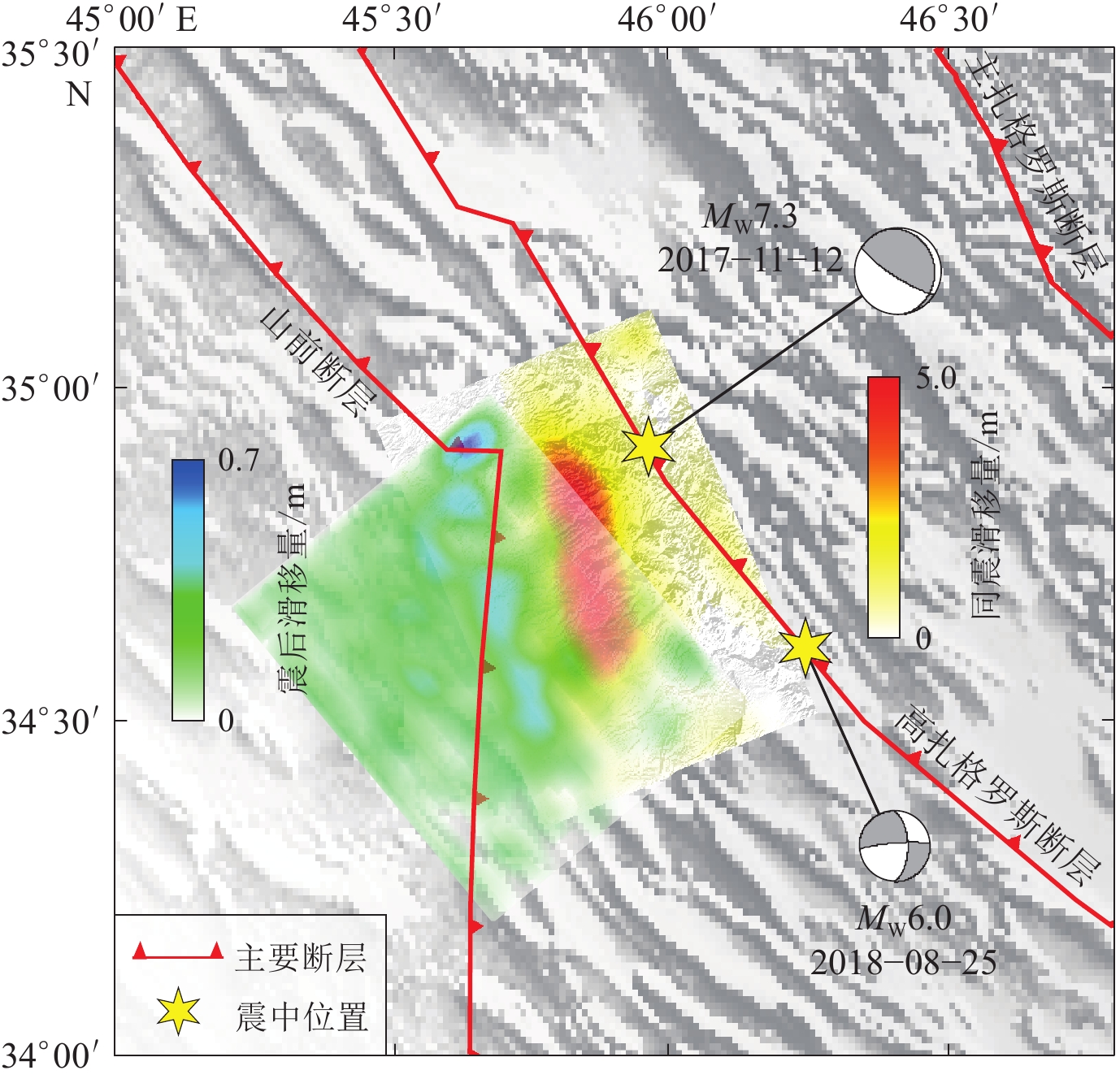Afterslip distribution of 2017 Iran MW7.3 earthquake and its triggering effects on the 2018 MW6.0 earthquake
-
摘要: 收集了覆盖监测区域的Sentinel-1卫星雷达影像,利用短基线集干涉测量技术提取了2017年伊朗萨波尔扎哈布MW7.3地震后283天的地表时序形变,通过二步法反演得到其震后余滑分布,之后采用差分干涉技术获取了2018年发生于同一地区的贾万鲁德MW6.0地震的同震形变场,并将反演所得的发震断层参数作为应力计算的接收断层参数,来分析2017年MW7.3强震及其震后活动对2018年贾万鲁德MW6.0地震的触发影响。结果表明:萨波尔扎哈布地震的震后形变主要由孕震断层面的余滑运动所致,震后283天余滑模型的累积滑移量达到0.7 m;2018年贾万鲁德地震的发震断层走向为355.6°,倾角为89.4°,同震断层破裂以右旋走滑为主,兼具部分正断层运动。本文所得的贾万鲁德地震断层平面上的库仑应力变化表明,2017年MW7.3主震及其震后余滑对2018年MW6.0地震的发生具有一定的触发效应,MW6.0地震的发生可能与区域板块的活动性相关。Abstract: In this study, a set of radar images acquired by the Sentinel-1 satellite that covers the interested seismically-effected area were collected. The time-series surface deformation of the 283-day time span after the 2017 Sarpol Zahab, Iran, MW7.3 earthquake was extracted by using small baseline subset technique, then the two-step procedure inversion is carried out to obtain the afterslip distribution. In order to analyze the triggering effects of the 2017 strong earthquake and its post-seismic faulting on the 2018 Javanrud MW6.0 earthquake, the coseismic deformation field covering the whole MW6.0 earthquake region was obtained by using differential interferometry technique, and the inversion results of seismogenic fault parameters were used as receiving fault parameters for stress calculation. The results show that the post-seismic deformation of the Sarpol Zahab earthquake is mainly dominated by the afterslip effect. 283 days after the earthquake, the accumulative slip of the after-slip model reaches up to 0.7 m. The coseismic source model of the Javanrud MW6.0 earthquake indicates that the seismogenic fault strike is 355.6°, the dip angle is 89.4°, and the rupture of coseismic fault is characterized by the right-lateral strike-slip together with some normal dip-slip component. Moreover, the calculated Coulomb stress change suggests that the MW7.3 earthquake and its afterslip have triggering effect on the subsequent Javanrud MW6.0 earthquake, and the occurrence of Javanrud earthquake could also be contributed by the regional plate activity.
-
-
图 6 2018年贾万鲁德MW6.0地震升轨(上)、降轨(下)的同震形变场及其模拟残差
(a) 观测形变场;(b) 模拟形变场;(c) 残差
Figure 6. Coseismic deformation fields and simulation residuals in ascending (upper) and descending (lower) orbits of the Javanrud MW6.0 earthquake in 2018
(a) Observed InSAR deformation field;(b) Simulated deformation field;(c) Residual
图 7 InSAR反演所得的贾万鲁德MW6.0地震的断层滑动模型
(a) 断层滑动空间分布;(b) 断层平面上的滑动分布,黄色星形代表2018年贾万鲁德MW6.0地震震源在断层面上的投影位置
Figure 7. Fault slip model of the Javanrud MW6.0 earthquake constrained by InSAR observations
(a) 3D view of the fault slip;(b) Slip distribution on the fault plane,where the yellow star represents the projected location of the hypocenter of the 2018 MW6.0 Javanrud earthquake
图 8 2017年萨波尔扎哈布MW7.3地震及其震后余滑在2018年贾万鲁德MW6.0地震发震断层上触发的库仑应力变化∆CFS
(a,b) MW7.3地震对 MW6.0地震触发的库仑应力变化∆CFS;(c,d) MW7.3地震的震后余滑对MW6.0地震触发的库仑应力变化∆CFS;(e,f) 本文计算使用的2017年MW7.3地震同震断层模型(Yang et al,2018b)。图中黄色和红色星形分别代表2018年MW6.0和2017年MW7.3地震震源在各自断层面上的投影位置
Figure 8. The Coulomb failure stress change ∆CFS on the fault plane of 2018 MW6.0 earthquake triggered by the 2017 MW7.3 earthquake and its afterslip
(a,b) ∆CFS on the seismogenic fault plane of the MW6.0 earthquake triggered by the MW7.3 earthquake;(c,d) ∆CFS on the fault plane of the MW6.0 earthquake triggered by the MW7.3 earthquake afterslip;(e,f) The coseismic fault of the 2017 MW7.3 earthquake used in the calculation of ∆CFS (Yang et al,2018b)。 The yellow and red stars represent the projected location of the hypocenter of the 2018 MW6.0 and the 2017 MW7.3 events on their fault planes
表 1 Sentinel-1A卫星的SAR影像参数
Table 1 SAR image parameters of Sentinel-1A satellite
轨道方向 监测时段 影像数量 波长/cm 飞行角/° 入射角/° 分辨率/m 升轨 2017-11-23—2018-08-14 12 5.6 −9.7 39.2 5×20 降轨 2017-11-19—2018-08-22 13 5.6 −167.0 43.9 5×20 表 2 Sentinel-1B卫星SAR影像参数
Table 2 SAR image parameters of the Sentinel-1B satellite
卫星类型 轨道方向 获取时间 飞行角/° 入射角/° 垂直基线/m 震前日期 震后日期 Sentinel-1B 升轨 2018-08-15 2018-08-27 −12.9 33.8 50.6 Sentinel-1B 降轨 2018-08-16 2018-08-28 −166.9 39.2 −22.6 -
郝平,傅征祥,田勤俭,刘杰,刘桂萍. 2004. 昆仑山口西8.1级地震强余震库仑破裂应力触发研究[J]. 地震学报,26(1):30–37. doi: 10.3321/j.issn:0253-3782.2004.01.004 Hao P,Fu Z X,Tian Q J,Liu J,Liu G P. 2004. Large aftershocks triggering by Coulomb failure stress following the 2001 MS=8.1 great Kunlun earthquake[J]. Acta Seismologica Sinica,26(1):30–37 (in Chinese).
贺克锋,赵斌,杜瑞林. 2019. 利用长期GPS数据研究2008年汶川地震震后形变[J]. 大地测量与地球动力学,39(2):122–126. He K F,Zhao B,Du R L. 2019. Post-seismic deformation associated with the 2008 Wenchuan earthquake by long-term GPS data[J]. Journal of Geodesy and Geodynamics,39(2):122–126 (in Chinese).
冀战波,王琼,王海涛,解朝娣. 2014. 2008年新疆于田MS7.3地震对后续地震的完全库仑应力触发作用[J]. 地震学报,36(6):997–1009. Ji Z B,Wang Q,Wang H T,Xie C D. 2014. Impact of complete Coulomb failure stress changes of the 2008 Xinjiang Yutian MS7.3 earthquake on the subsequent earthquakes[J]. Acta Seismologica Sinica,36(6):997–1009 (in Chinese).
李健,詹文欢,朱俊江,孙杰,冯英辞,姜莲婷,郭磊,唐琴琴. 2017. 1990年菲律宾MW7.7级强震对马尼拉俯冲带静态应力触发影响[J]. 海洋地质与第四纪地质,37(6):93–99. Li J,Zhan W H,Zhu J J,Sun J,Feng Y C,Jiang L T,Guo L,Tang Q Q. 2017. A preliminary study on static stress triggering effects on Manila subduction zone by the Philippine MW7.7 earthquake 1990[J]. Marine Geology &Quaternary Geology,37(6):93–99 (in Chinese).
单斌,李佳航,韩立波,房立华,杨嵩,金笔凯,郑勇,熊熊. 2012. 2010年MS7.1级玉树地震同震库仑应力变化以及对2011年MS5.2级囊谦地震的影响[J]. 地球物理学报,55(9):3028–3042. doi: 10.6038/j.issn.0001-5733.2012.09.021 Shan B,Li J H,Han L B,Fang L H,Yang S,Jin B K,Zheng Y,Xiong X. 2012. Coseismic Coulomb stress change caused by 2010 MS=7.1 Yushu earthquake and its influence to 2011 MS=5.2 Nangqên earthquake[J]. Chinese Journal of Geophysics,55(9):3028–3042 (in Chinese).
万永革,吴忠良,周公威,黄静. 2000. 几次复杂地震中不同破裂事件之间的“应力触发”问题[J]. 地震学报,22(6):568–576. doi: 10.3321/j.issn:0253-3782.2000.06.002 Wan Y G,Wu Z L,Zhou G W,Huang J. 2000. “Stress triggering” between different rupture events in several earthquakes[J]. Acta Seismologica Sinica,22(6):568–576 (in Chinese).
万永革,沈正康,兰从欣. 2005. 兰德斯地震断层面及其附近余震产生的位移场研究[J]. 地震学报,27(2):139–146. doi: 10.3321/j.issn:0253-3782.2005.02.003 Wan Y G,Shen Z K,Lan C X. 2005. Study on displacement field generated by aftershocks in Landers seismic fault plane and its adjacent areas[J]. Acta Seismologica Sinica,27(2):139–146 (in Chinese).
万永革,沈正康,盛书中,徐晓枫. 2009. 2008年汶川大地震对周围断层的影响[J]. 地震学报,31(2):128–139. doi: 10.3321/j.issn:0253-3782.2009.02.002 Wan Y G,Shen Z K,Sheng S Z,Xu X F. 2009. The influence of 2008 Wenchuan earthquake on surrounding faults[J]. Acta Seismologica Sinica,31(2):128–139 (in Chinese).
文磊,张光亚,李曰俊,温志新,张强,赵岩. 2015. 扎格罗斯褶皱冲断带构造变形特征[J]. 地质科学,50(2):653–664. doi: 10.3969/j.issn.0563-5020.2015.02.020 Wen L,Zhang G Y,Li Y J,Wen Z X,Zhang Q,Zhao Y. 2015. Structure-deformation features of the Zagros fold and thrust belt[J]. Chinese Journal of Geology,50(2):653–664 (in Chinese).
杨百存,秦四清,薛雷,张珂. 2018. 2017年伊拉克MW7.3地震的类型界定及其震后趋势分析[J]. 地球物理学报,61(2):616–624. doi: 10.6038/cjg2018L0737 Yang B C,Qin S Q,Xue L,Zhang K. 2018. Identification of seismic type of 2017 Iraq MW7.3 earthquake and analysis of its post-quake trend[J]. Chinese Journal of Geophysics,61(2):616–624 (in Chinese).
张庆云,李永生,张景发. 2020. 2017年伊朗MW7.3地震震源机制反演及三维形变场获取[J]. 武汉大学学报(信息科学版),45(2):196–204. Zhang Q Y,Li Y S,Zhang J F. 2020. Focal mechanism inversion and 3D deformation field acquisition of Iran MW7.3 earthquake in 2017[J]. Geomatics and Information Science of Wuhan University,45(2):196–204 (in Chinese).
Deng J S,Sykes L R. 1997. Evolution of the stress field in southern California and triggering of moderate-size earthquakes:A 200-year perspective[J]. J Geophys Res,102(B5):9859–9886. doi: 10.1029/96JB03897
European Space Agency. 2014. ASF data search vertex[DB/OL]. [2019-09-20]. https://search.asf.alaska.edu/#/.
Feng W P,Samsonov S,Almeida R,Yassaghi A,Li J H,Qiu Q,Li P,Zheng W J. 2018. Geodetic constraints of the 2017 MW7.3 Sarpol Zahab,Iran earthquake,and its implications on the structure and mechanics of the northwest Zagros thrust-fold belt[J]. Geophys Res Lett,45(14):6853–6861. doi: 10.1029/2018GL078577
Guo R M,Zheng Y,Xu J Q,Riaz M S. 2019. Transient viscosity and afterslip of the 2015 MW8.3 Illapel,Chile,earthquake[J]. Bull Seismol Soc Am,109(6):2567–2581. doi: 10.1785/0120190114
Hatzfeld D,Molnar P. 2010. Comparisons of the kinematics and deep structures of the Zagros and Himalaya and of the Iranian and Tibetan Plateaus and geodynamic implications[J]. Rev Geophys,48(2):RG2005.
He P,Wen Y M,Xu C J,Chen Y G. 2019. High-quality three-dimensional displacement fields from new-generation SAR imagery:Application to the 2017 Ezgeleh,Iran,earthquake[J]. J Geod,93(4):573–591. doi: 10.1007/s00190-018-1183-6
Hsu Y J,Simons M,Avouac J P,Galetzka J,Sieh K,Chlieh M,Natawidjaja D,Prawirodirdjo L,Bock Y. 2006. Frictional afterslip following the 2005 Nias-Simeulue earthquake,Sumatra[J]. Science,312(5782):1921–1926. doi: 10.1126/science.1126960
Jahani S,Callot J P,Letouzey J,Frizon de Lamotte D. 2009. The eastern termination of the Zagros fold-and-thrust belt,Iran:Structures,evolution,and relationships between salt plugs,folding,and faulting[J]. Tectonics,28(6):217–234.
Jónsson S,Segall P,Pedersen R,Björnsson G. 2003. Post-earthquake ground movements correlated to pore-pressure transients[J]. Nature,424(6945):179–183. doi: 10.1038/nature01776
King G C P,Stein R S,Lin J. 1994. Static stress changes and the triggering of earthquakes[J]. Bull Seismol Soc Am,84(3):935–953.
Lin J,Stein R S. 2004. Stress triggering in thrust and subduction earthquakes and stress interaction between the southern San Andreas and nearby thrust and strike-slip faults[J]. J Geophys Res,109(B2):B02303.
Lohman R B, Simons M. 2005. Some thoughts on the use of InSAR data to constrain models of surface deformation: Noise structure and data down sampling[J]. Geochem Geophys Geosyst, 6(1): Q01007.
Marone C J,Scholtz C H,Bilham R. 1991. On the mechanics of earthquake afterslip[J]. J Geophys Res,96(B5):8441–8452. doi: 10.1029/91JB00275
Mora O,Mallorqui J J,Broquetas A. 2003. Linear and nonlinear terrain deformation maps from a reduced set of interferometric SAR images[J]. IEEE Trans Geosci Remote Sens,41(10):2243–2253. doi: 10.1109/TGRS.2003.814657
Okada Y. 1985. Surface deformation due to shear and tensile faults in a half-space[J]. Bull Seismol Soc Am,75(4):1135–1154. doi: 10.1785/BSSA0750041135
Peltzer G,Rosen P,Rogez F,Hudnut K. 1998. Poroelastic rebound along the Landers 1992 earthquake surface rupture[J]. J Geophys Res:Solid Earth,103(B12):30131–30145. doi: 10.1029/98JB02302
Taymaz T, Nilfouroushan F, Yolsal-Çevikbilen S, Eken T. 2018. Co-seismic crustal deformation of the 12 November 2017 MW7.4 Sar-Pol-Zahab (Iran) earthquake: Integration of analysis based on DInSAR and seismological observations[C]//Proceedings of 2018 EGU General Assembly. Vienna, Austria: EGU2018-4186-6.
USGS. 2017. M7.3: 29 km S of Halabjah, Iraq[EB/OL]. [2020-07-15]. https://earthquake.usgs.gov/earthquakes/eventpage/us2000bmcg/moment-tensor.
USGS. 2018. M6.0: 32 km SW of Javanrud, Iran[EB/OL]. [2020-07-15]. https://earthquake.usgs.gov/earthquakes/eventpage/us1000ghda/moment-tensor.
Yang C S,Han B Q,Zhao C Y,Du J T,Zhang D X,Zhu S N. 2019. Co- and post-seismic deformation mechanisms of the MW7.3 Iran earthquake (2017) revealed by Sentinel-1 InSAR observations[J]. Remote Sens,11(4):418. doi: 10.3390/rs11040418
Yang Y H,Chen Q,Xu Q,Liu G X,Hu J C. 2018a. Source model and Coulomb stress change of the 2015 MW7.8 Gorkha earthquake determined from improved inversion of geodetic surface deformation observations[J]. J Geod,93(3):333–351.
Yang Y H,Hu J C,Yassaghi A,Tsai M C,Zare M,Chen Q,Wang Z G,Rajabi A M,Kamranzad F. 2018b. Midcrustal thrusting and vertical deformation partitioning constraint by 2017 MW7.3 Sarpol Zahab earthquake in Zagros mountain belt,Iran[J]. Seismol Res Lett,89(6):2204–2213. doi: 10.1785/0220180022
Zhao B,Bürgmann R,Wang D,Tan K,Du R,Zhang R. 2017. Dominant controls of downdip afterslip and viscous relaxation on the postseismic displacements following the MW7.9 Gorkha,Nepal,earthquake[J]. J Geophys Res:Solid Earth,122(10):8376–8401. doi: 10.1002/2017JB014366





 下载:
下载:








